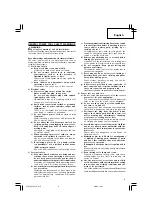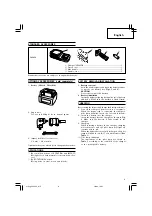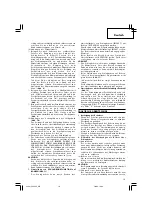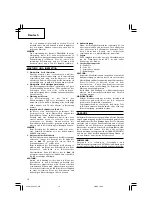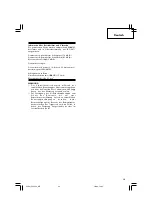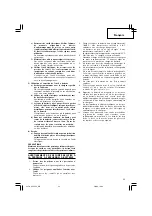
English
7
5) Battery tool use and care
a) Recharge only with the charger specified by the
manufacturer.
A charger that is suitable for one type of battery
pack may create a risk of fire when used with
another battery pack.
b) Use power tools only with specifically designated
battery packs.
Use of any other battery packs may create a risk
of injury and fire.
c) When battery pack is not in use, keep it away from
other metal objects like paper clips, coins, keys,
nails, screws, or other small metal objects that can
make a connection from one terminal to another.
Shorting the battery terminals together may
cause burns or a fire.
d) Under abusive conditions, liquid may be ejected
from the battery; avoid contact. If contact
accidentally occurs, flush with water. If liquid
contacts eyes, additionally seek medical help.
Liquid ejected from the battery may cause
irritation or burns.
6) Service
a) Have your power tool serviced by a qualified repair
person using only identical replacement parts.
This will ensure that the safety of the power tool
is maintained.
PRECAUTION
Keep children and inl rm persons away.
When not in use, tools should be stored out of reach of
children and infirm persons.
CORDLESS IMPACT DRILL SAFETY
WARNINGS
1.
Wear ear protectors with impact drills.
Exposure to noise can cause hearing loss.
2.
Use auxiliary handles supplied with the tool.
Loss of control can cause personal injury.
3.
Always charge the battery at a temperature of 0 –
40°C. A temperature of less than 0°C will result
in over charging which is dangerous. The battery
cannot be charged at a temperature higher than
40°C. The most suitable temperature for charging
is that of 20 – 25°C.
4.
Do not use the charger continuously.
When one charging is completed, leave the charger
for about 15 minutes before the next charging of
battery.
5.
Do not allow foreign matter to enter the hole for
connecting the rechargeable battery.
6.
Never disassemble the rechargeable battery and
charger.
7.
Never short-circuit the rechargeable battery. Short-
circuiting the battery will cause a great electric
current and overheat. It results in burn or damage
to the battery.
8.
Do not dispose of the battery in fire.
If the battery is burnt, it may explode.
9.
When drilling into wall, floor or ceiling, check for
buried electric power cable, gas pipe, etc.
10.
Bring the battery to the shop from which it was
purchased as soon as the post-charging battery
life becomes too short for practical use. Do not
dispose of the exhausted battery.
11.
Using an exhausted battery will damage the
charger.
12.
Do not insert foreign object into the air ventilation
slots of the charger.
Inserting metal objects or inflammables into the
charger air ventilation slots will result in electrical
shock hazard or damaged charger.
13.
When mounting a bit into the keyless chuck, tighten
the sleeve securely. If the sleeve is not tight, the
bit may slip or come off, causing injury.
Model
DV24DV
No-load speed (1: Low/2: High)
0 – 400/0 – 1750 min
–1
(/min)
No-load impact rate (1: Low/2: High)
0 – 7200/0 – 31500/min.
Concrete (1: Low/2: High)
20 mm/10 mm (Depth 30 mm)
Capacity
Wood (1: Low/2: High)
38 mm/20 mm (Thickness 40 mm)
Steel (1: Low/2: High)
13 mm/8 mm (Thickness 1.6 mm)
Rechargeable battery
EB2420 (2.0 Ah)
Ni-Cd battery, 24 V
EB2430 HA (3.0 Ah)
Ni-MH battery, 24 V
Weight
4.0 kg
SPECIFICATIONS
POWER TOOL
CHARGER
Model
UC24YFB
Charging voltage
24 V
Weight
0.6 kg
01Eng_DV24DV_WE
5/8/09, 16:05
7







